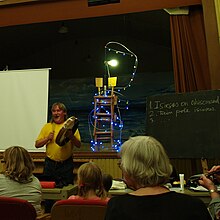Urmas Sisask

Urmas Sisask in 2011.

Estonian TV Girls' Choir with Urmas Sisask at St Paul's cathedral in London, 2008.
Urmas Sisask (born 9 September 1960, in Rapla) is an Estonian composer.[1]
One of the major inspirations for his music is astronomy. Based on the trajectories of the planets in the solar system, he created the "planetal scale", a mode consisting of the pitches C#, D, F#, G#, and A. Later, he discovered to his surprise that this was exactly the same as the Japanese Kumajoshi mode, which is also known as the Japanese pentatonic scale.
Sisask is a Roman Catholic, and much of what he composes is sacred music. His younger sister is singer and actress Siiri Sisask.
Some of his works[]
- Starry Sky Cycle (Estonian: "Tähistaeva tsükkel") (1980–1987)
- Gloria Patri (1988)
- Pleiads ("Plejaadid") (1989)
- Milky Way ("Linnutee galaktika") (1990)
- Andromeda ("Andromeda galaktika") (1991)
- Benedictio (for mixed chorus) (1991)
- Christmas oratorio ("Jõuluoratoorium") (1992)
- Magnificat
- Missa Nr. 1
- Symbiotic Symphony ("Sümbiootiline Sümfoonia")
- Comet Hyakutake
- Ave Sol
- Missa Nr. 4 op. 46: Christmas mass ("Jõulumissa")
- Polaris ("Põhjanael")
- Veni Sancte Spiritus
External links[]
References[]
- ^ "Urmas Sisask". Fennica Gehrman. Retrieved 2020-07-04.
Categories:
- 1960 births
- Living people
- 20th-century classical composers
- 21st-century classical composers
- Estonian Roman Catholics
- Tallinn Music High School alumni
- People from Rapla
- Male classical composers
- Estonian Academy of Music and Theatre alumni
- 20th-century Estonian composers
- 21st-century Estonian composers
- 20th-century male musicians
- 21st-century male musicians
- Recipients of the Order of the White Star, 4th Class
- European composer stubs
- Estonian musician stubs
